|
1.
CENTRAL/ WEST AFRICA
Markets quiet ahead of Chinese New Year
Log prices remained unchanged since the end of December 2007. Azobe was slightly weaker due
to lower demand from European buyers. Belli was also down because of ongoing negotiations by
Indian buyers and reduced demand from China. Moabi prices were up on very good demand by
France, where markets had held very firm through the last quarter of 2007. Sapele and sipo
logs had also been in strong demand in France, Germany and China, where supply of these species had
been too low and buying had taken place despite recent gains in price. Production also had been
barely sufficient to satisfy the renewed buying activity. Apart from these particular
demand surges, exporters reported that demand from Europe had been slow throughout the Christmas and New
Year vacations.
As anticipated, European markets were very dull and demand was low with exporters receiving only
sporadic enquiries to fill gaps in stock of particular species such as sapele and sipo. Demand for all
markets were moderate though shipments for China and India were proceeding at
slightly lower levels. Exporters from Gabon awaited news on the proposed full implementation of a revised log
quota system while importers will want to assess the potential impact of any overall restriction in
the volume available for export.
At end December, sawn lumber prices had been stable though higher demand for sapele and sipo
did allow producers to raise prices by EUR40/ m3 for sapele GMS FAS with competition from
traditional buyers [such as] Spain and high demand from China. Sipo also rose by
EUR50/ m3 for GMS FAS and EUR25/ m3 for scantlings, with especially firm demand from France and Germany.
Yet, producers noted that competition from Far East meranti may become more intense with prices
expected to be around EUR600/ m3 for KD sawn lumber against EUR620 to EUR640/ m3 for sapele
and sipo. Some exporters predicted that sapele prices might weaken slightly in the first quarter,
though might be offset by the shorter supply route and faster delivery times for West
African timbers.
At the start of the New Year, markets for sawn lumber were very quiet. Some European traders
were forecasting much lower consumption in the first quarter, by much as 25% less demand than
during the same period in 2007. These opinions may well be speculated on the basis of the
sub-prime financial problems triggered by the property market problems in the US and are
spreading to Europe. Certainly, the UK housing market is slackening, although
the current slow pace is quite normal given the time of year. Underlying demand for houses remains very strong,
with the government proposing some 2-3 million new homes to be built to satisfy demand from the rising
population. West African producers report good demand, although there are supply problems due to
heavy rains, particularly in Cameroon. There is some concern that West African prices may be in
doubt as reports indicate that Asian mills have also been subject to higher domestic log
prices, poor weather for logging and much increased freight costs, which puts them at a disadvantage in
negotiating prices. The Chinese New Year will be celebrated this year in mid-February, when
production tends to be reduced.
West African sawn lumber prices have remained very firm and have held on to gains experienced
during the 4th quarter of 2007 for selected species. Lumber price movements to date have revealed
that no prices fell during 2007 and some 18 premium species made substantial
gains, notably sapelli and sipo, which were up around EUR100/ m3 and bubinga FAS GAS, which moved up
some EUR200/ m3. Douka also was in high demand with increases of EUR102/ m3 for GMS and EUR60/
m3 for scantlings. Moabi, tiama/kossipo and padouk prices all appreciated around EUR60 to
EUR75/ m3 range. Okoume lumber also made some inroads in the market and added
around EUR75/ m3 FAS GMS. Ayous and movingui had modest gains, within the usual range of EUR18
and EUR30/ m3. Iroko had a mixed year with prices moving within a range of EUR5 to EUR20/ m3
in response to demand variations, but ended the year virtually unchanged.
The current firm stand on prices by Asian exporters seems likely to hold markets steady at least
through the first quarter of 2008.
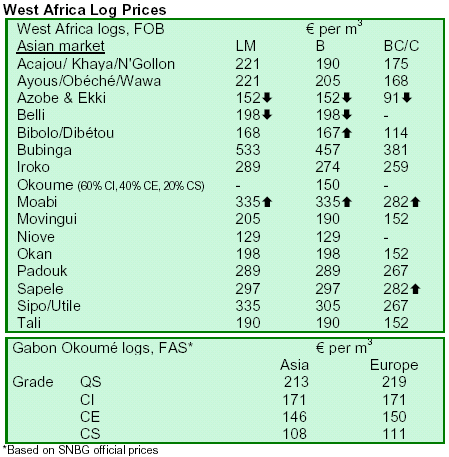

2. GHANA
Ghana inaugurates Timber Rights Evaluation
Committee
The Minister of Lands, Forestry and Mines inaugurated a seven-member Timber Evaluation Rights
Committee to ensure strict compliance with the provisions of the Timber Resources Management
Act of 1997. The Committee has been tasked to evaluate applications for Timber Utilization
Contracts in accordance with qualifications and criteria as provided by regulations made under Act.
The Committee will also rank the qualified applications on merit through a competitive procedure
prescribed by regulations under the Act.
20% jump in export contracts in third quarter
Third quarter export contracts processed and approved were 200,395 m3 in volume, a 19.8% rise
from the volume of second quarter contracts. The expansion in contract volume was mainly due to
the continuous increase in volume of plywood exports to the West Africa sub-region.
Nigeria continued to be the leading importer of plywood during the quarter under review, importing 70% of
contracts approved. The volume of plywood contracts approved increased 55.25% compared to the
previous quarter, registering at 95,437m3.
With the exception of poles, billets and logs, which increased by 4.74% and reached a volume of
19,007m3, almost all the major exportable products experienced contraction in volume during the
quarter under review. Moldings/processed lumber, sliced veneer, rotary veneer
and lumber declined by 38.36%, 20.94%, 8.81% and 2.65% to 2,863m3, 9,006m3, 7,855m3 and 55,126m3,
respectively.
Ghana exported a total of 4,510 pieces of furniture parts, down 50.32% from second quarter
exports. Most of the furniture exported was garden furniture and significant
orders were made during the first and second quarters of the year to satisfy consumer demand during the summer
months of the third quarter.
Ghana signs interim EPA with EU
On 13 December 2007, Ghana signed the interim Economic Partnership Agreement (EPA), or
EPA-lite, with the European Union. The agreement would provisionally allow 80% of some European
goods into the Ghanaian market duty-free and quota-free while Ghana will continue to have 100%
access to the EU market, with the exception of sugar and rice. The EPA was established
as a bilateral business partnership agreement between the European Union (EU) and the African
Caribbean and Pacific (ACP) countries and designed to replace the Cotonou Agreement which
expired on 31 December 2007. The signing of the agreement was intended to avoid
disruptions of trade with the EU, since under the World Trade Organization (WTO) rules, the EU would be
required to place tariffs on Ghana's exports.
Prior to the signing of the EPA-lite, civil society groups advocated against signing any reciprocal
and nonpreferential trade agreement between ACP and the EU contending that the agreement was
not the best for the ACP countries as it would cripple local industries and make these countries
dependent on EU imports. The parties are already negotiating the larger EPAs, which
would guarantee a reciprocal opening of each country's market and the zero-rating of imports and exports.
Meanwhile, the largest umbrella body of manufacturers in the country, the Association of Ghana
Industries (AGI), has backed the signing of the provisional trade agreement,
since the framework would allow the country more time to enhance its competitiveness in global markets.
Key substitutes chalk up gains in prices
Odum prices could not improve as it did during the second quarter of 2007. Prices were generally
down between EUR5 and EUR10 for Kiln Dried (KD) lumber and experts speculate that prices could
continue to fall. However, prices of dahoma, a close substitute of odum, were gradually rising at its
main destination market, the Middle East. Dahoma contracts approved during the
quarter under review achieved an average price of USD350 m3 for Air Dried (AD) lumber, up from the
previous quarter average of USD315 m3.
The price of khaya ivorensis, which was stagnant during the last quarter of 2006 and the first quarter
of 2007, substantially rebounded. There were instances where contracts were closed in excess of
USD50 for KD Lumber as compared to the Timber Industry Development Division
GSP. The sharp increase could be attributed to the ban on exports of Swietenia, a substitute for Khaya ivorensis
from the South American countries to the US. This prompted most buyers to focus on West Africa
for more volumes of Khaya ivorensis.
Prices for prime species of sapele, makore and utile sustained gains at an average of EUR20/ m3
during the quarter under review as they did during the second quarter. Prices of wawa were firmed
with marginal average increases of EUR5/ m3 for most contracts approved during
the quarter. Additionally, a contract for dowels between Birim Wood Complex and Transglobal was closed at a
price of EUR410/ m3 to Germany using the Lesser Used Species of yaya and watapao. The
product was previously produced using mainly koto.
During the quarter under review, the Forestry Commission approved the exports of legally sourced
Gmelina in round form. To this effect, a contract had already been signed between Asia
International of India and Subri Industrial Plantation Limited at a price of USD125 m3.
Utility costs trigger hike in inflation
Inflation for November 2007 hit a year high of 11.4%, according to information released by the
Ghana Statistical Service. This was a significant hike over the 10.1% recorded in October 2007. The
sharp rise was largely due to higher electricity, gas and water tariffs implemented at
the beginning of November as well as petroleum price increases that took effect later in the month.
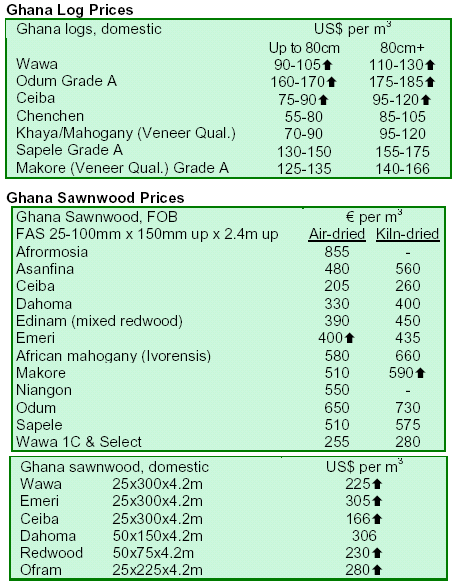
3.
MALAYSIA
Trade surplus jumps 21.6% in November 2007
According to Bernama online, Malaysia recorded a trade surplus of RM10.45 billion in November
2007, up 21.6% from the previous month. The gain was driven by continued export growth of palm
oil and petroleum products, the Ministry of International Trade and Industry
(MITI) said in a press statement. Exports rose to RM54.36 billion in November 2007, up 5.7% from a year earlier.
Imports increased by 3.9% to RM43.91 billion.
Solid export growth in November was greatly helped by stronger intra-Asia trade, offsetting weaker
exports to the US. Malaysia's exports to the US dropped sharply by 16.5% to RM7.6 billion in
November 2007, compared to November 2006. However, timber prices continued to
slide as real estates and construction industries in major export markets begin to cool. The slide in prices is
expected to ease by March 2008.
Two FMUs lose MTCC certfication
TTJ reported that the Selangor and Terengganu Forest Management Units (FMUs) in Malaysia
would not have their certificates for forest management renewed. The announcement came as a
result of the application of the 2002 Malaysian Timber Certification Council
(MTCC) Malaysian Criteria, Indicators, Activities and Standards of Performance for Forest Management (MC&I).
Although certified under the 2001 standards, the two FMUs will need to take corrective actions to
comply with the new 2002 standards. As a result, the forest area in the FMUs is
not being recognized as certified until the units comply with the new standards.
Meanwhile, the Pahang FMU has received MC&I (2002) certification. Periodic audits will be carried
out in the FMU during the five-year certificate's validity period, in order to ensure compliance with
the MC&I (2002) standards. Additionally, the Negeri Sembilan FMU has recently received MTCC
certification.
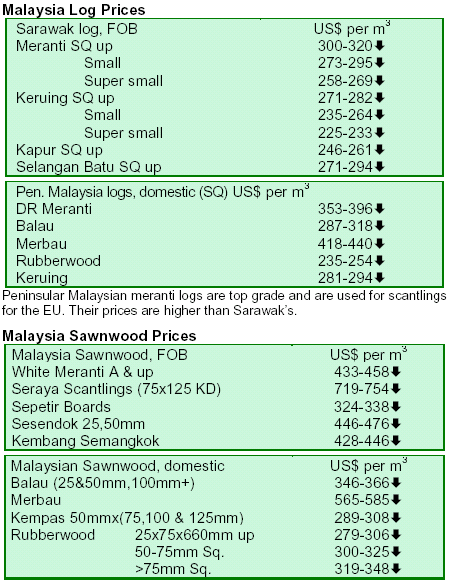
4.
INDONESIA
Economic growth anticipated to reach record highs
Antara News reported on the Indonesian Central Bank's announcement that Indonesian economic
growth was forecast to hit 6.3% in 2007. This record level of growth, the highest since the 1997
Asian financial crisis, was driven by heightened consumption and exports as well as
the country's improving investment climate. Additionally, at the end of 2007,
Indonesia's foreign exchange
reserves rose to USD56.9 billion, from USD54.9 million in November 2007.
In early January, timber prices in Indonesia declined, but on a lesser scale than those in Malaysia.
However, this might change as increasing oil prices would continue to exert upward pressure on the
Indonesian currency in the foreign exchange markets.
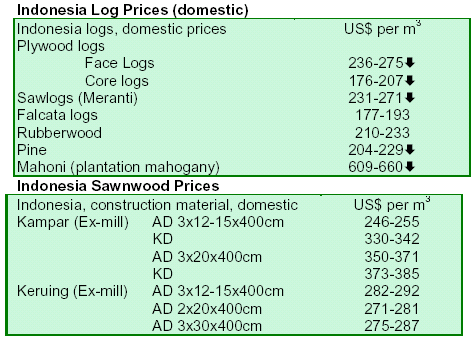
5.
MYANMAR
Preference for natural teak drives demand up
At the start of the New Year, demand for Myanmar teak was firm, since many buyers continue to
prefer natural teak over plantation teak. December 2007 tender prices for higher grades (preferred by
Europe, US and Japan) remained strong, while those for lower grades (preferred
by other buyers) declined. However, such periodic fluctuations are normal. The quantity of teak sold in
tenders is relatively small and teak is sold mostly through direct sales contracts to the East. Grades sold by
direct sales are usually SG-5 and lower.
The January tender sales bring forth controversial speculations. Some say that prices may retain
their December vitality and remain fairly resilient. Others say scarcity of logs from preferred areas
could bring down prices. It is still be too early to forecast the area-wise composition of logs in the
January tender. Due to the New Year holiday, some buyers may stay away from the
markets, and with lesser competition, prices could be subdued. Tender prices, whether going up or down, have
had a strong effect on the market since MTE has decided to use six month average prices for its direct sales.
The bulk of (non-teak) hardwood logs is sold directly to contractors doing extraction for MTE. These
extraction companies make forward sales to their regular customers accepting advance payments.
When logs are sold to spot buyers, who are not regular buyers, prices are normally
higher.
Pyinkado log prices in December 2007 remained in the list price range of USD470 to USD500.
Such prices are reasonable for freshly cut logs, which are at present in relatively good demand.
Remaining logs from previous seasons are said to be traded at lower prices depending on
diameter and degree of freshness and larger diameter logs are in higher demand. Gurjan is also said to be in
good demand for fresh logs. The list price for gurjan logs used in veneer peeling, construction and
container flooring is USD325 to USD352 depending on extraction area. Spot or
random buyers may buy from tenders or from extraction contractors or their buyers. In such cases, prices may
become more inflated by about USD100. The actual premium varies from time to time depending on the
quality of the goods.
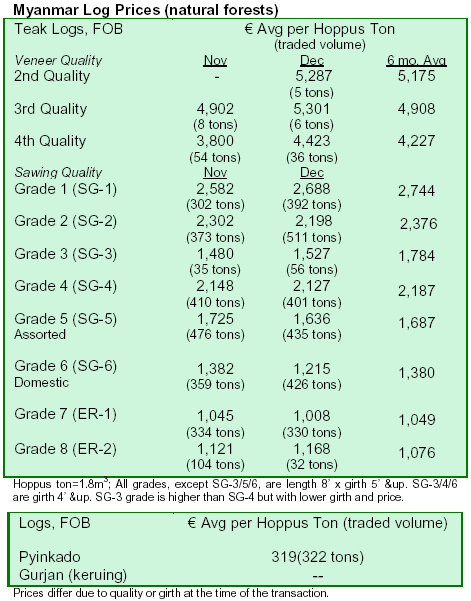
6. PAPUA
NEW GUINEA
Incentives attract more investments in downstream
processing
The forestry sector plays an important part in PNG's economy and is the third revenue earner after
oil/minerals and agriculture. The exports of processed products continue to increase as more
national and international investors consider downstream processing, which has a
salutary effect on sustainable forest management and investment returns. Downstream processing offers an
attractive incentive to investors, as there is currently no tax on exports of processed timber. Round log
exporters pay a tax of 28.6% per m3 of FOB value as well as a development levy of USD2.80 per
m3 of logs exported. There are certain levies and premium payable to the landowners by the log
exporters, currently set at USD3.50 per m3 for logs harvested (inclusive of log exports and
domestic processing). There is limited promotion of lesser used species in PNG and most of
PNG's timber
species are known in the major markets.
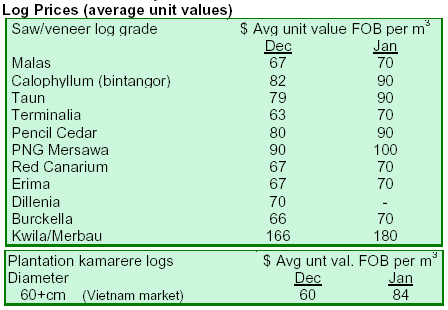
7.
BRAZIL
Northern Brazil sees better prospects in 2008
Aimex/Portal Madeira Total reported on new prospects for the forestry sector in Northern Brazil for
2008. Despite the sector's lackluster year in 2007, stakeholders in the sector
are optimistic that the sector can recover, especially since a new policy on managing public forests at the federal and
state levels will help wood processing mills in the state of ParĄ§¢ secure increased timber supply.
However, the sector still needs to overcome other obstacles, such as the approval for forest
management plans before obtaining adequate timber supply.
Brazil's exports climbed marginally in November 2007
In November 2007, exports of general wood products (excluding pulp and paper) increased 2.7%
compared to the same period last year, growing in value from USD344.8 million to USD353.9
million. Pine sawnwood exports rose 5.7%, from USD20.2 million in November 2006 to USD 21.4
million in the same month of 2007. However, the volume of pine sawnwood exports decreased
2.5% from 109,400 m3 to 106,700 m3 over the period. Exports of tropical sawnwood also eased in
volume, from 149,200 m3 to 138,600 m3 in November 2007 compared to December 2006. On the
other hand the export value of tropical sawnwood increased 9.9%, from USD 58.8
million to USD 64.6 million.
Exports of pine plywood expanded 25% by value in November 2007 compared to November 2006.
The corresponding export volume fell 6.2%, indicating a price increase for the product. The export
volume of pine plywood in November 2006 was 132,100 m3, while in the same month of 2007 it was
124,100 m3, corresponding to USD 34.1 million and USD 42.7 million, respectively.
Tropical plywood exports slumped from 35,840 m3 in November 2006 to 28,678 m3 in November 2007, a fall
of 19.9%. There was also a decline in value of 12.1% for tropical plywood exports, from USD 35.8
million to USD 28.6 million.
The exports of wood furniture decreased 12% in November compared to the same month in 2006.
The exported value of this product decreased from USD74 million to USD 65.1 million.
Buoyant trade in Brazilian solidwood products boost prospects for 2007
Higher prices for solidwood products in international markets and new investments in civil
construction have helped compensate the loss suffered by the Brazilian solidwood industry in
recent years. According to the Brazilian Association of Mechanically Processed Wood
(ABIMCI), the total value of wood sector sales amounted to USD5 billion in 2006, of which USD2.5 billion was
from the international trade. A 15% hike in this trade value is likely to be reflected in 2007 data.
Despite this positive scenario, ABIMCI forecasts overall lower investments than previously
expected. For the 2005-2014 period, investments in the wood industry are now forecast at
USD5 billion.
Price increases for solidwood products in international markets have reached up to 30% in some
segments, due to higher demand for wood products in the European civil construction market and
rising production costs in some competing countries such as China and Finland. Pine
plywood, the main export product of the Brazilian solidwood sector, has been sold at prices higher than the
historic average (USD240/ m3). Prices for pine plywood rose from USD210/ m3 in the first half of
2006 to USD270 m3 in the same period of 2007.
Exports of solidwood, which includes mostly plywood, sawnwood, veneer, doors, floors and
woodcrafts, reached a total of USD2.6 billion last year, a 3.9% increase over
2005. The main destination markets were Europe and the US, with the Middle East becoming an increasingly
significant export destination. Europe generated more demand than the US, as exports to the US
have been drastically reduced as a result of falling housing construction and the hike from 0 to 8%
in US import tax on Brazilian plywood. ABIMCI expects growth in domestic consumption of
solidwood products in the range of 25% to 30%, due to an anticipated rise in the civil
construction market associated with the federal government's ¡®Development Acceleration
Programme'.
Proceeds from confiscated timber for environment protection
O Liberal reported that ParĄ§¢ is the first Brazilian state to sign an agreement with the Brazilian
Institute of Environment and Renewable Natural Resources (IBAMA) to donate all confiscated
materials obtained from its inspection operations. The agreement, which is already in
force, aims to optimize environmental control, inspection, protection and preservation. The agreement includes not
only confiscated timber but also other seized materials such as trucks and timber lorries, which will
be sold through auctions.
The money to be collected from the auctions will be used for environmental preservation. According
to IBAMA's ParĄ§¢ Regional Office, it has nearly 20,000 m3 of confiscated timber in the Highway
BR-163 region alone, which could be auctioned. The State Secretariat of the Environment
(SEMA) expects to donate the financial resources to NGOs and build low-income housing and
bridges.
All information on the agreement's implementation will be made available to the public through the
internet. A system of public participation will also be created. The five-year agreement will be
monitored by follow-up meetings to be held twice a year between IBAMA and SEMA for the
evaluation of results.
Brazil redoubles efforts to fight deforestation in 2008
Despite economic growth and agriculture development fueled by high commodity prices, Brazil has
experienced relatively low deforestation rates in the Amazon, reported
Envolverde. Deforestation rates in the Amazon peaked during the period August 2003-July 2004 (27,379 km2),
but dropped to 11,224 km2 during the same period in 2006-2007. This was the second lowest annual
deforestation rate registered since the control system was implemented in 1988. However, from August to
November 2007, the rate jumped 10% compared to the same period in 2006.
The decreasing rate over the last three years was due to several factors, such as government plans
to control deforestation in the Amazon in 2004, stricter sanctions applied to illegal activities, the
establishment of new conservation areas and actions taken by consumers' and
environmentalists' campaigns. However, economic factors were identified as one of the major determinants putting
pressure on the Amazon, due to low prices for soybeans and the limited expansion of agriculture
and cattle ranching.
The challenge to the Brazilian government is to halt deforestation even though the national economy
is growing and prices of agricultural products are high. The expanding sugar cane plantations for
ethanol production are also listed as a factor exerting indirect pressure on the
Amazon forests. While such plantations are in nearby areas of the Amazon, land prices have appreciated as a
result of the plantations and have encouraged the opening of new forest areas for agricultural plantations
and cattle ranching.
The government will concentrate efforts against deforestation in 32 municipalities with the largest
deforested areas in the last few years. To kick start the efforts, a governmental decree in December
2007 included provisions that landowners must register their properties with precise measurements using new technologies and
proper monitoring. Violators are now subject to penalties such as losing access to bank credit, losing property and
additional fines. In addition, illegal deforestation will result in an embargo being placed on the land and its
production capabilities, which means that the penalty will be applied to buyers of animals or products coming from
the identified area.
Mato Grosso timber exports surge 31%
According to TVCA/Diario da Noticia, statistics of the Mato Grosso Federation of Industries
(FIEMT) showed that timber exports grew 31% in total value compared to the period from January to
September 2006. According to the Veneer and Plywood Industry Association of the state
of Mato Grosso, the positive result was due to the growth of civil construction, which generated growth in
the domestic market, and continued to stimulate international demand. The value of exports, which
was 80% of production, increased from USD129 million to USD170 million.
Brazilian furniture exports rise despite strong Real
MIC/SECEX/MDIC/CGI Moveleiro indicated that Brazilian furniture exports had grown continually
despite the appreciation of the Brazilian Real in relation to the US dollar. According to the Ministry
of Development, Industry and Foreign Trade, exports of furniture increased 6.6% by value from
January to November 2007. Exports increased 0.26% in November 2007 compared to exports
in November 2006.
Exports to the US, accounting for 25% of Brazil's exports in November 2007, have continued to
decrease. Between January and November 2007, exports to the US dropped 21% compared to the
same period in 2006. Exports to the EU kept growing, with a 10.6% increase compared to
2006. Exports to the UK also grew 5.2% in 2007 compared to 2006 and received 14% of
Brazil's exports.
Rio Grande do Sul, the second biggest exporting state, exported USD260 million in value from
January to November 2007, a 7.8% surge compared to the same period in 2006. Santa
Catarina, the largest exporting state, showed a small 0.3% rise in the same period.
Phaunos to develop teak and eucalypt plantations in Brazil
TTJ reported that the Phaunos Timber Fund will be developing teak and eucalypt plantations in
Brazil. The firm has dedicated USD150 million in the deal with Nemus, a Brazilian firm, to develop
Nemus's FSC certified eucalypt and teak plantations. Phaunos has also purchased about 4,000 ha
in Uruguay to grow short rotation eucalypts.
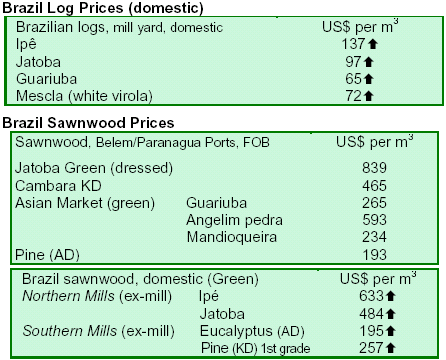
8. PERU
Analysts expect
Peru's New Sol to hold below S/3.00
Based on reports from analysts in major banks, it is expected that Peru's New Sol will not be
higher than S/3.00 to USD1.00 in 2008. Analysts also do not rule out a fall in Latin American
currencies due to the persistent pressure of overseas markets. The highest risk to the
currency is the possible recession in the US and the slowing of the global economy.
Free Trade Treaty aims to protect Peru's environment
The implementation of the Free Trade Treaty (FTT) between Peru and the US, signed on 14
December 2007, aspires to improve commercial and environmental standards to achieve
sustainable environmental growth. In accordance with the FTT, exportable supply of goods must
fulfil the demands of the markets in terms of the quality of the product, sustainable production, fair
labor and an adequate legal framework for environmental protection. This will stimulate the
introduction, application and control of better environmental practices. The lead FTT
negotiator for Peru, Pablo De la Flor, commented that the FTT is a tool that will contribute to the promotion of the
environment and encourage investment in environmental activities. De la Flor also noted that Peru
has signed numerous international environmental agreements, such as the UN Convention on
Biological Diversity and the Kyoto Protocol under the UN Framework Convention on Climate
Change.
Peru records marginal rise in wood product exports
Peru's wood products exports from January to October 2007 reached USD147.0 million, increasing
1.46% compared to the same period in 2006. Furniture and components showed the most growth
during January to October 2007, rising 20.4%. Parquet and plywood rose 15.13% during the same
period and manufactured products rose 11.97%. Those products decreasing in value
were sawnwood (4.71%), structural timber (4.8%) and woodsheets, plaques and veneer (92%).
Sawnwood was still the main item exported, representing 51.13% of the total share of exports and
USD89 million in value. Semimanufactured products held 25.87% of the sector share in
the same period and generated USD45 million in value. Furniture and components generated USD14.7 million
in the period from January to October 2007, while exports for the same period in 2006 were
USD12.2 million, resulting in a gain of 20.4% compared to 2006 exports. The value of wood sheets
and plywood was USD18.7 million in January to October 2007.
As in the last three years, the three main destination markets for exports of Peruvian wood products
were the US, Mexico and China. Exports to the US fell 17.8% compared to the same period in 2006
and US share of Peru's wood exports dropped 40.64% in 2006 to 32.93% in 2007. Mexico, the
second largest destination of Peru wood products, increased its imports by 26.6% and held
31% of Peru's exports. Exports to China, the third largest importer of
Peru's wood products exports,
dropped 5.64% and held a market share of 19.5%.
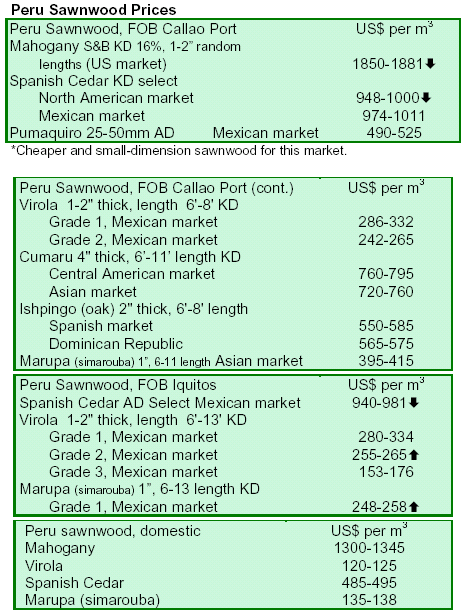
9. BOLIVIA

10.
Guyana
Marginal rise in forest products exports value despite
lower volume
In 2007, the export of forest products from Guyana increased by 3%, or approximately USD2 million
when compared to 2006. Total value of exports for 2007 was USD61.5 million. This is despite of a
33,500 m3, or 18%, decrease in the volume of logs exported. Sawn timber, round logs and plywood
accounted for the bulk of the products exported. Other important products included
garden furniture, shingles and doors.
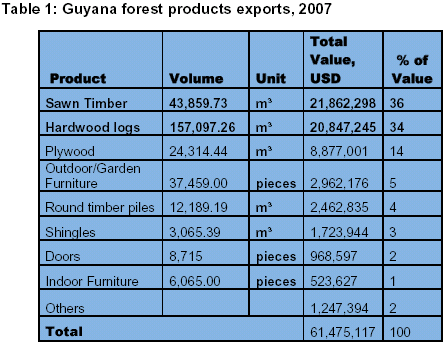
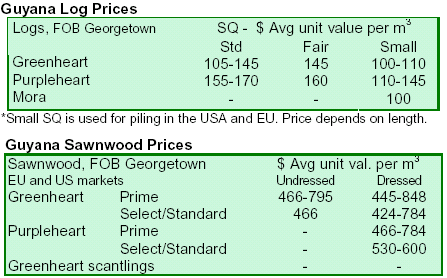
|